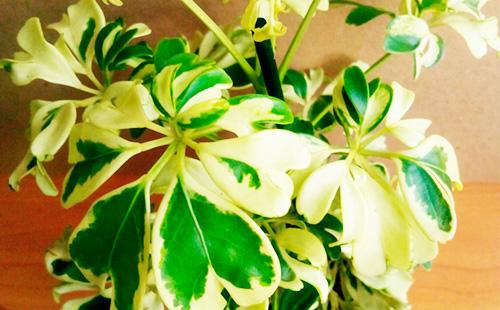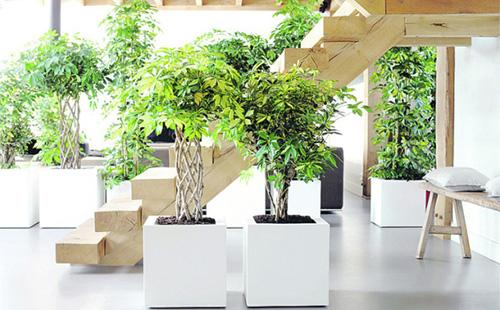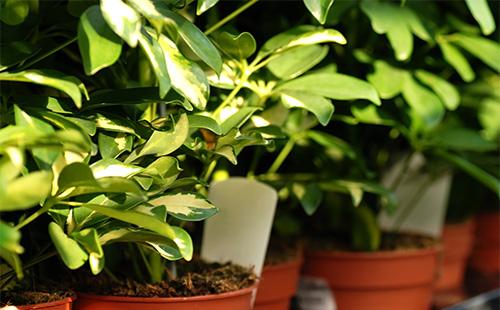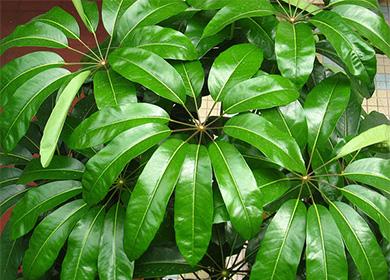The content of the article
Knowledgeable gardeners say: a home garden on the windowsill is created by trial and error. The latter cannot be avoided, even if you read all the clever "flower" encyclopedias. However, without knowledge, it is difficult to provide conditions that a new plant will like. Care for a shefflera is even possible for an ordinary grower.
Botanical characteristic
The beautiful, graceful Scheffler (Latin name - Shefflera) belongs to the largest Araliev family, bears the name of the famous botanist - German floral scientist Jacob Scheffler. Known in nature as the "umbrella tree" and has more than 200 species. Arriving from Australia and New Zealand, a Scheffler will add a tropical note to your interior.
The most famous is Schefflera actinophylla (maximum height 60 cm, has a proportional shape). New varieties are Schefflera arboricola "Hong Kong" and Schefflera arboricola "Geisha Ger". The maximum height of these plants is 1.5 m. The flower has a number of features that make it easy to distinguish from others.
- The color of the sheet. The plant is presented in two colors. These are either glossy, monophonic bright green leaves that give the impression of being well polished. Or it is motley foliage interspersed with white or yellow.
- Sheet shape. The leaf consists of four to twelve small lobes, leaflets that grow from one center and look in different directions. Associatively resemble the needles of an umbrella or a spread palm.
- Inflorescence. Scheffler flowers are like tentacles. But it is unlikely to be lucky to contemplate them: in a pot, the plant does not bloom (only in natural conditions).
- Features of the structure. Sheffler's room grows with a bush or an elegant tree. It has fragile stems, therefore, during the growing season, the trunk of the plant must be attached to the support.
Acclimatization process
It is important to know how to care for the shefflera after purchase. The main mistake of the debutant grower is to immediately put the plant on the sunny windowsill. Of course, this is done with the best of intentions. However, keep in mind the fact that the “overseas” indoor plant gets into the living conditions from the greenhouse, where the flowers are grown using intensive technology. There, with the help of the optimal temperature regime and growth stimulators, it is possible to achieve maximum decorativeness of the flower in a short time.
Once in the apartment without the usual “dope”, the plant experiences extreme stress and suffers. To make the shefflers adaptation period as painless as possible, follow four recommendations.
- Quarantine. The first thing to do is to place a new flower in a bright but shaded area. Away from other plants to avoid their infection by any pests.
- Watering. Usually, when you buy, you get a thoroughly moistened plant, so you should not water the sheffler at home until the lump is dry.
- Microclimate. The humidity in the apartment is lower than the greenhouse, so irrigate the leaves of the shefflers daily, and it is better to place a container of water next to the plant. Another good option is to put the pot on a stand with damp small pebbles. If you do not maintain the required high level of humidity, then the edges of the leaves will dry out.
- Transshipment It is precisely this method of transplantation that suits the “new settler” flower, when the plant is simply taken out of the transport pot and transplanted into a new, slightly larger one. In this case, an earthen lump with roots is not disturbed. The plant can be easily taken out of the pot on the eve of watering it. All that remains is to turn the container over, tilt it slightly and, gently tapping the outer walls of the pot, carefully remove it. If the earthen lump cannot be removed without assistance, use a knife and carefully separate it from the walls of the pot.
Please note that these two concepts are not synonymous. Regarding the shefflers, opinions are divided: some recommend transferring it to a new pot right away, others a week later. In any case, it is necessary to observe the flower, which will undergo a stressful period of adaptation.
How to care: 10 rules
The ornamental plant does not need excessive attention, but the basics of competent care for the shefflera are necessary for everyone who decides to bring it to the house. The following ten rules are necessary for a comfortable flower life.
- The location. Scheffler will be snug on the windows facing east and west. Drafts and proximity to heating appliances and batteries are harmful to her. But Scheffler’s conditioners are not indifferent: in such climatic conditions, the flower develops much better, but you should not place the pot directly under the cold air stream.
- Temperature. 20 ° C - a favorable temperature for growing shefflers in the summer. Night cooling has only a positive effect on the plant. In the warm season, it is advisable for the Scheffler to arrange a summer "vacation" by placing a flower on the balcony. In winter, the plant does not tolerate temperature conditions colder than 12 ° C (ideal 15-17 ° C).
- Lighting. Sheffler will be grateful for the bright lighting, however, direct sunlight is contraindicated to her. Varieties of shefflers with pure green leaves successfully develop in partial shade (an excess of light will provoke the appearance of light spots). Variegated plants require greater illumination: with a lack of light, the leaves will turn faded or the flower will lose its motley color altogether.
- Watering. Here it is important to find a “middle ground”, avoiding either drying out or overmoistening the soil (an excess of water can cause loss of deciduous cover, rotting of roots and even death of shufflers). In spring and summer, it is recommended that the flower be watered the next day after the top layer of the earth has dried up a couple of centimeters. In winter, watering is reduced. For water procedures use only settled water.
- Moisture content. Given the tropical origins of shefflers, provide the plant with high humidity. At home, the Tropicana Scheffler requires frequent spraying (up to two times a day). A shower is especially desirable for a plant wintering in a very warm room. In addition, a pot with room shefflera can be placed on a pallet with moistened coarse sand or expanded clay. An alternative to irrigation is to wipe the leaves with a damp cotton pad. The use of an ultrasonic humidifier in a room with a sheffler is welcome.
- Priming. For cultivation, the following shredders are ideal, all components of which are taken in equal proportions: deciduous land (for looseness and nutrition), turf land (dense, nutritious, has good water and air permeability), humus,peat and sand (necessary for root health). You can buy a storehouse mix for palm trees and ficuses. Scheffler definitely needs drainage (expanded clay, vermiculite, ordinary pebbles, broken shards or pieces of polystyrene foam).
- Top dressing. Fertilize the soil without fail. They feed the flower during the growing season. From spring to autumn, fertilizer is applied twice a month for ornamental deciduous plants. And in the period between top dressing, the soil is sprinkled with a tablespoon of crushed egg shells. In winter, the room Scheffler does not need additional food.
- Pruning. To make the plant look more decorative and branching, it is necessary to form a crown of shefflers. To do this, cut the apical shoot five internodes down. After the appearance of new lateral shoots, you can begin to form a spherical crown. Tall plants are recommended to be halved in the spring in order to stimulate the growth and density of side shoots.
- Topping. You can create a sheffler in the form of a standard tree by the following method: cut off all the lower shoots, and pinch the top for further branching. Performing annual spring pruning and pinching, you can form any desired shape.
- Transfer. Young plants are transplanted annually, adults - after two to three years in a more spacious pot. When transplanting, shufflers completely clean off the old soil. This procedure requires accuracy so as not to harm the roots.

Reproduction: 4 ways
Shefflera flower propagation is possible in three main ways: cuttings, seeds and aerial roots. The most popular method is to root the sheffler using cuttings. Seeds are used much less frequently due to the non-flowering of this elegant bush-like plant at home. In addition, a sheffler can give life to a new plant with a leaf. The probability that the leaf will take root is low, but they often resort to this method of breeding.
Cuttings
Features The main condition for successful grafting is constant soil heating to 20-22 ° C. Help in this mini-greenhouse with lower heating.
Breeding process
- For the procedure, we select well-developed, healthy, numbing cuttings.
- Cut them with a sharp knife.
- We place the cuttings for six to eight hours in a solution of heteroauxin (an organic growth stimulator of indoor plants).
- We plant them in pre-harvested soil. Its composition is peat and sand in equal parts.
Seeds
Features Shefflers seed propagation begins with the purchase of seed material in a flower shop or greenhouse. It is quite possible to plant a sheffler in a seed way at home, although the process is quite lengthy. The period of laying seedlings is early spring.
Breeding process
- We prepare a container with soil: we take sand and peat in an equal amount. The second version of the mixture is sand, turf and deciduous land in the same proportion.
- Soak the seeds in a solution of stimulants "Zircon" or "Epin" (according to instructions). You can just in warm water.
- We plant seeds to a depth of 10 cm. The distance from each other is a few seeds.
- After watering, we create greenhouse conditions: place the container under a film or glass and take it out to a warm place.
- Regularly ventilate the seedlings, irrigate the soil.
- After the appearance of two or three full-fledged leaves, the processes are transplanted into separate small pots and grown for three months at a temperature of no more than 19 ° C, then we lower the air temperature to 15 ° C.
- In autumn, we shuffle the shuffler into a larger diameter pot.

Air layering
Features A sheffler itself does not provide aerial roots or layering for propagation. They need to be grown independently.
Breeding process
- On the trunk of an adult, large flower, make a small incision.
- We apply moss to the notch. If there is no moss, it can be replaced with a medical bandage.
- Wrap with plastic wrap.
- The notch should always be wet. To do this, regularly wet the moss, creating a greenhouse effect under the polyethylene necessary for the formation of processes.
- After the appearance of aerial roots in the incision site, cut off the top of the shoot and plant it in a separate pot.
Leaf
Features Sheffler can be propagated by leaf. The ideal time for this is the end of January-February.
Breeding process
- Gently tear off the leaf from the stem along with the “leg”.
- Pour water with a growth stimulator into a small container.
- Wrap the base of the sheet with cotton and lower it into the prepared container with liquid.
- We place it on a warm battery and cover with a cropped plastic bottle.
- Regularly ventilate the sprout.
We diagnose: diseases ...
Constant attention and inspection of indoor plants is the key to their health and good immunity. Diseases of flowers are associated mainly with improper care. But if in time to identify and eliminate the causes of the disease, then the decorativeness of the plant will not suffer. More often than not, the following seven signs indicate ailments of shufflers.
- Leaves fade and stain. Excess light causes the appearance of bright spots, and its lack makes the foliage faded. Dry air provokes the appearance of black spots on the leaves.
- Dry the edges of the leaves. This happens if the sheffler is very hot and not enough moisture. Drafts may also be the cause. Your task is to provide the Scheffler with a comfortable microclimate.
- Root rot. In excessively flooded colors, the root system rots. The soil is swamped, which provokes the development of microorganisms. Transplantation into fresh soil with the obligatory removal of rotten particles will save the sheffler. The roots are washed with Fitosporin or Trichodermin, dried, sprinkled with charcoal or cinnamon. The transplanted sheffler is not watered for several days.
- Blackness on the stem. Abundant watering and, as a consequence of this, rot and fungus lead to the blackness of the tops of the shefflers. Immediately you need to cut the stem below the place of decay, and then check the roots for rot. If necessary, treat them with an antifungal drug.
- Sheffler unnaturally stretched out. The plant suffers from heat, so identify it in a cool, bright place.
- Leaves fall. The summer reason is in high air temperature and lack of moisture, the winter reason is in too low temperature and excess watering of the plant.
- Leaves turn yellow. The reason is lack of nutrition. It will solve the problem of feeding the plant with complex fertilizers three times a month during periods of active growth. Another reason for the yellowness of the leaves is an overabundance of mineral fertilizers (especially nitrogen).

... and pests
Traditional insect pests do not mind eating a tropical plant, thereby depriving the sheffler of vitality. This is a spider mite, scale insect, mealybug and thrips. There are several methods to get rid of them. The simplest is to wipe the leaves (especially their inner side) with a soap solution.If such a simple procedure does not help, then you need to use insecticides or fungicides. Each type of parasite pest has its own treatment characteristics.
- Spider mite. The appearance of small gray and yellow spots on the leaves of the shufflers should cause alarm. Immediately the tick is invisible: it hides under the underside of the leaf, feeding on its juice. Over time, the area of damage to the plant increases, the silver coating of the web becomes noticeable, and upon careful examination, the living moving mass. The flower withers, does not grow, leaves and stems crack. Effective treatment consists in using the chemicals “Actellik”, “Neoron”, “Vermitek”, “Fitoverm”, diluted in water according to the instructions. Folk remedies will also help - a solution of laundry soap, water tincture of garlic. Also take care of high humidity.
- Shield. It affects any part of the plant, looks like small yellow-brown spots on the underside of the leaf. First, sticky dew forms on the affected flower, then the leaves turn yellow and fall, the sheffler does not grow and wither. The sick sheffler needs to be isolated from the rest of the flowers, wipe the leaves with soap and water and treat with insecticides.
- Thrips. The appearance of these subtle insects is indicated by gray-brown spots on all surfaces of the flower. Scheffler needs urgent isolation and treatment with a strong solution of laundry soap. If necessary, use insecticides.
- Mealybug. This is a small, oval insect with a white, like flour, coating. The pest is collected from the plant manually, and the residues from the leaves and stems are removed with water or a cotton pad moistened with alcohol, and in case of a massive lesion - with Confidor, Aktara solutions. The mealybug does not tolerate moisture, so constantly spray the sheffler.
Signs and superstitions
All houseplants have long been associated with their good and bad omens. According to knowledgeable flower growers, a sheffler also has hidden magical properties. Below are the most common judgments, to believe which is everyone's personal business:
- the leaves are getting dark - in the room an excess of negative energy;
- leaves fall - to illness or financial failure living in the house;
- leaves are folded - to conflict at work or at home;
- the plant stopped growing - failures are coming;
- sudden growth shefflers - to replenish in the family.
Proper care of the shefflera at home will ensure the harmonious development of the plant, which according to Feng Shui theory is considered a very positive flower that brings harmony to the home atmosphere. Scheffler rallies the family, quenches anger and anger. A person living in the same house with a shefflera becomes kind and attentive. Exotic plant absorbs negative energy and anxiety. The best place for shefflers is the bedroom. For the productive study of a child-student, it is appropriate to place a plant next to his desk. If you believe the reviews, the Scheffler favors people born under the signs of Aries, Leo and Sagittarius.

